“We had to have trust in the people”, Former Cadre Tells the Court
Today, former commune chief Sao Van testified on issues regarding the treatment of Lon Nol soldiers and authority structures in Kieng Svay Commune. He had testified on July 07, 2015 in front of the Supreme Court Chamber. He confirmed his earlier statement that former Lon Nol officials up to the rank of Colonel “should not be touched”, even though he was unsure about the meaning of different ranks. He further indicated that operations involved Vietnamese people being gathered and sent away to Vietnam, but that the instructions were that they should not be harmed.
Village, front and commune chief
At the beginning of the session, the Trial Chamber Greffier confirmed the presence of all parties, including Nuon Chea, who was following the hearing from his holding cell. She announced that witness 2-TCW-989 would be heard today. The President Nil Nonn first issued an oral ruling on a request by the Co-Prosecution of November 11, 2015.[1] It was a request to use three documents, which the President admitted.
The testimony of 2-TCW-989 then began. Witness Sao Van alias Pok was born on April 15, 1941 in Srae Khav Village, Cheang Tong Commune, Tram Kok District, Takeo Province. The witness had testified in this court in February 2015 in front of the Supreme Court Chamber. The President wanted to know whether he was also known as Sao Pok, which he confirmed. Since the witness had been called by the Trial Chamber, the President started the examination of the witness.
The President wanted to know how he could remember the exact date of his appointment as Cheang Tong’s commune (30 April 1971), as he testified in front of the Supreme Court Chamber.[2] The witness replied that Angkar of District 105 provided him an appointment to promote him to commune chief at the front of Cheang Tong commune. He was chief of the front until 975, after which he was reassigned to Sector 25. Two months after the “victory date” on April 17, 1975, he was reassigned. He was reassigned to be chief of Kieng Svay Commune in Sector 25 in 1976. From 17 April 1975 until he was reassigned, he was responsible for the evacuees in his village in Cheang Tong to place these people in the cooperative. The female person Boeun had overall supervision within the Commune, while he was tasked to manage the people.
The President then asked what the difference was between the front of the commune and his tasks as in the Commune Committee. He replied that the Chief of the Front within the commune and Chief of the Commune “had relatively the same tasks.” All the decisions had to be agreed upon by all three, after which the commune chief was invited to the meeting so that the decisions could be implemented. The President wanted to know whether he was Chief Deputy or committee member. He replied that he worked at the front and that the tasks he had talked about were the tasks of the commune committee. He was transferred to Sector 25 by Yeay Khom.
Meetings
He was reassigned to work at Kieng Svay in 1976 and stayed there for a year. He asked whether he had attended a meeting at Phnom Trael, which the witness confirmed. The meeting was held on the mountain itself and lasted all day. The President wanted to know whether he knew someone called Moeun Vet, which he denied. The President said this witness Moeun had said that Phnom Trael was called “regional conference hall”.[3] Mr. Van said that he only knew the place as Phnom Trael.
He received an invitation letter that was sent from the sector down to the commune. Phnom Trael was located in District 106, Sector 13 (currently known as Kampot Province). Many people attended the meeting, which took place after April 17, 1975. Unit Chiefs were also present, and Saom from Sector 13 was the speaker. He could not remember other speakers. They discussed living conditions, as well as their victory. He said that former Lon Nol soldiers, until the rank of colonel, “should not be touched.”, because they were “needed for the revolution”. This was emphasized by Saom during the meeting.
The President wanted to know whether Saom had mentioned former civil servants of the Lon Nol regime. Mr. Van replied that he did not, but he had stated that “we should have a broader perception of the old and the new people. And that we should try to find the solution with the masses”, notably find solutions for food shortages.
The President referred to the witness’ DC-Cam 2011 interview and wanted to know whether, when he referred to Phnom Trael and Phnom Trae, he referred to the same location.[4] The witness replied that he referred to Phnom Trael. Since he had said that it was held by Ta Mok, the President wanted to know whether this was the same meeting or a different one. He replied that he attended an annual meeting by Ta Mok around 1973. The decision to kill people was “in the hands” of the zone and the sector.
The President sought clarification about the categories of Lon Nol soldiers that were supposed to remain “untouched”: from the colonel downwards or from the ranked soldiers upwards? The witness answered that it was from the colonel down to the lower level.
Treatment of Lon Nol soldiers
The President inquired as to whether those that had the rank of colonels and above were harmed. Mr. Van said that he “never saw the mistreatment of these soldiers. No such incident happened in the Cheang Tong commune.”
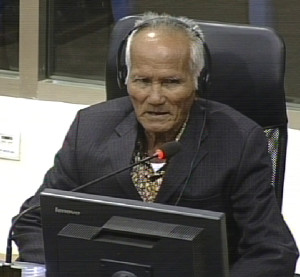
Witness Sao Van
The President asked what his observation was in relation to the treatment of colonels “down” and colonels “up”. He said that the colonels “up” had been sent away already before his arrival, and he did not know where. He did not know how many people were sent out of Kieng Svay in Kampong Svay.
The President then inquired what he meant when he said that what happened during the regime was different from what was in the documents and what Ta Mok said. The witness replied that he received a document in late 1977 and mid-1978, in which were mentioned categories of “full rights people”, “candidate people” and “depositees.” He saw skulls and bones when he was in Kraing Ta Chang. This is what he was referring to when talking to the interviewers, and not to what Ta Mok had said.
The President further inquired how the instructions by Ta Saom were implemented. He answered that he disseminated the instructions to the village chiefs and to his subordinates upon in arrival in Kieng Svay.
The President turned to another meeting at Takeo Town. He said that he attended a meeting there after April 17, 1975. The presentation was also made by Saom. It was meant to give advice on production and motivating the masses, and did not mention Lon Nol soldiers.
The meeting at Phnom Trael was held first. Ta Mok invited him to the meeting in Takeo Town.
The meeting was held inside Psa Chha (Old Market). Soldiers, cadres from the communes and cadres from the districts 25, Kampot and Sector 13 were invited to the meeting.
They went to Takeo with vehicles. The meeting lasted three days. It was held in 1976, “perhaps in June or July”. The meeting was presided over by Ta Saom and Ta Bit. Ta Mok also attended the meeting, but was there “to simply listen”. Living conditions were discussed. There were around 300 participants from regimental level, battalion level and members of 100-unit and 50-units. The production unit at Srae Ambel was also invited. The subject of the meeting was about “the conclusion of the war and the furthering of the democratic revolution. And it was said that it was now the time to turn to social revolution. And we were told to promote our agricultural production to reach three tons per hectare so that we could defend our country.”
It was either Ta Mok or Ta Saom who mentioned the soldiers. “He said for us, all the comrades, we had to acknowledge that after the victory, we had to have trust in the people. And also, if we were to be defeated, we had to rely and trust the people. He emphasized that for us the cadres, we had to acknowledge the masses. And that’s not only about those at the basis, but for the soldiers in the areas as well. So in our capacities as cadres […] we had to eliminate our personal egos. And that we had to be absolute with our stance.” They had to not distinguish between Old and New People, but to include everyone in the production.
The President wanted to know whether he attended a meeting where policies were disseminated and where people from all three sectors in the Southwest Zone participated in. He answered that he only attended the meeting in Takeo.
When the President inquired about a statement he had made in his interview, the witness said that he might not remember the specific fact.[5] “However, I was already in Kieng Svay when I was called for a meeting in Takeo Town.”
Revolution
Peasants were divided into three classes previously: the poor peasants, the middle-class peasants and the rich parents. He himself was with the masses. “And after the popular revolution, I noticed the consolidarity [sic]” amongst the people, which made him “delighted” with “unity of our nation”. This is what made him remember that soldiers with the rank of colonels were not to be harmed, because the relatives of the soldiers were also part of the revolution. This is why he was “so happy” to hear that statement made by Saom.
He was commune chief in Kieng Svay in 1976.
What I recall is that Chea, the Sector 25 Committee, told me two phrases that I recall up to today, because these two phrases actually perplexed me and I wanted further answers to that. The one term was that ‘The brain knew.’ And the second phrase is that ‘the special friendship or special solidarity’. And allow me to broaden these two phrases. First, the phrases were brand-new. Chea, the Sector 25 Committee, gave us his view on this issue during the yearly conference held in Sector 25. He said, within the framework of the popular revolution, the flame of war in Cambodia had extinguished. However, the ashes were still warm. And, at that time, that the US Mayaguez ship actually encroached into the Kampuchean territorial waters and the American dropped bombs in Siem Reap, which destroyed the lives of the Kampuchean children.
And as regards the special solidarity, he said that Chea had said that Vietnam liberated a Cambodian area despite the victory on 17 April 1975 on the 30 of April.
We had to acknowledge that they wanted a special relationship or special solidarity; that there should be one country and one people without border. However, I still wanted more answers from that phrase. And I wanted to see what’s going to happen. And I wanted to see who’s going to step on whose toes. And he said that we were on a juncture where the popular revolution ended and that we reached the point where we had to engage in the socialist revolution to defend and build the country
in which no distinction was made between old and new forces: “we had to strengthen our solidarity to gather all forces to engage in the production.” He said that this was the content of the meeting, in which he participated in the capacity as the Kieng Svay chief.
Sao Van’s Brother
The President inquired whether he had any relative who was part of the Lon Nol regime. He answered that he had an older brother called Sao Sum. They came from a poor peasant family. His older brother worked in a shoe factory in Phnom Penh. There was a commune election in the quarter, in which his older brother was elected third on the list during the Sihanouk Regime. He held this position also during the Lon Nol regime.
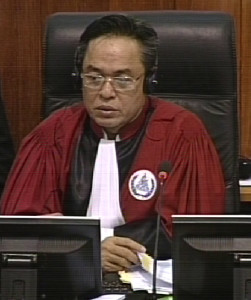
Trial Chamber President Nil Nonn
After the war ended in 1975, his older brother had said that he was transferred to the North in Kampong Som Province. Two months later, he came back to Chea Tong Commune, but now lived in another commune. After he returned to Cheang Tong Commune, “he went to our house, but I did not meet him at the time. The village chief sent him to the district, because they learned that he was a former official and he came from Phnom Penh. So he was sent to live in an education area in Sector 24. Then I went to see him for one time before I was transferred to Kieng Svay.” “Of course I still had my personal family attachment to my older brother. I was shocked when he was sent to the center. So I went to see Yeay Khom, who was the district secretary and who was the daughter of Ta Mok.” He told her that his brother had been sent to the district without having educated his brother. Yeay Khom told him that he should return to work. “She instructed me to bring the wife and children of my older brother to go and live with my older brother in Sector 24. So that was the intervention that I made for my elder brother.” He did not go to see the center itself, but saw the supervisor of the center, Chheng, instead. He told this supervisor to look after his older brother. “And please try to be lenient on him. And I told Chheng that my brother was not physically strong, so I sought his understanding and permission for my elder brother. Then I said goodbye to him and I left.” He did not let anyone from the district committee know that he went to the supervisor, since he went there in his private capacity. He went there by foot. It was around ten kilometers away. His brother was in the center between 1975 and1979. He was not aware of any other position that his brother might have held during the Lon Nol period.
Food Rations
The President then turned to the topic of food rations in the Southwest Zone. He wanted the witness to explain what “two cam” (sic) of rice mixed with corn meant.[6] He replied that he spoke about the measurement of rice and corn. He heard about this food ration from Yeay Bhor. One kilogram consisted of around ten “cams”. He confirmed that two “cams” were around one fifth of a kilogram. This was to be cooked in a large pot together. There was no distinction of the food ration between the senior cadres and villagers, according to Mr. Van.
The President then referred to the minutes of a meeting of March 08 1976, which indicated that workers were to be given “two cans of rice or a little more”.[7] The President asked whether this was the same measurement. The witness answered that they received “two cams” of rice. In 1976, they did not have sufficient rice. “Immediately upon my arrival, Ta Mok suggested and told me that each person should be provided with two cams of rice […] per day, based on practical circumstances.” They had two meals per day.
At this point, the President adjourned the hearing for the lunch break.
After the break, the President turned back to the topic of food rations. He first asked how many meals he had per day when working in Cheang Tong Commune in Sector 105 and in Kieng Svay in Sector 25. He answered that the food ration was not limited during war time. Some communes suffered from food shortages while others did not. In Kampong Svay, New People had communal meals. In 1976, the food was not sufficient. After 17 April 1975, the food was not sufficient, he said, “particularly for the general public.” If one family had three or five members, “they would receive the supplies accordingly, since the food situation was not good yet.”
The President stated that he had said in his testimony that people in Kampong Svay had sufficient food and that a surplus was given to Angkar. He wanted to know whether he had sufficient food to eat when he was in Cheang Tong. He answered that after 17 April 1975, the “food situation in Cheang Tong was not sufficient.” When being in Kampong Svay, “the food was not in surplus.” However, they had corn to supplement their food. Later, there was an instruction to give people two “cams” of rice mixed with rice. Thus, people had enough to eat. “No food shortage happened in Kampong Svay commune, but let me point out again that people had rice with corn.” He denied that any food shortage existed there. However, “no surplus was given to Angkar in 1976.” In 1977, he was reassigned to live in another sector.
The President referred to minutes of the Standing Committee of 22 February 1977, in which 10,000 bags of rice were mentioned.[8] The President wanted to know whether he was aware of this when he was the commune secretary. He replied that he was unable to tell the Court how many tons of rice were given to him. When the President asked him whether the food rations were different according to their age, he said that he may have forgotten about that, but that in general everyone received the same food rations.
The President gave another document to the witness, in which the food rations were depicted.[9] When he worked at Boeng Kang commune, there was a rice surplus. There was no food shortage there.
Treatment of the Vietnamese
The President turned to the last topic, namely the treatment of the Vietnamese. He inquired whether there was any mistreatment against the Vietnamese by the cadres after 17 April 1975 in his commune and neighboring commune. He said that people were evacuated from Phnom Penh. There were below ten Vietnamese families in Cheang Tong Commune. There was an instruction that “Vietnamese people had to be gathered up” in a pagoda “and that their lives should never be touched or harmed. The same applied to their properties. Their property “should not be deprived”, due to the foreign policy that was in place. Yeay Khom convened a meeting and informed the cadres of Cheang Kong to convey the matter. Subsequently, he ordered the village chiefs to gather the Vietnamese up at Wat Rokha to send them back to Vietnam. He further recalled that they had received instructions that“there was no benefit to hate those Vietnamese people.” If Vietnamese possessed arms, however, they should be confiscated.
Membership in the Communist Party of Kampuchea
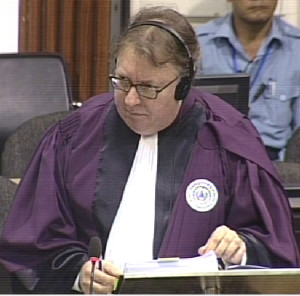
International Senior Assistant Prosecutor Dale Lysak
The floor was then granted to the Co-Prosecutors. Mr. Lysak turned to the witness’s membership in the party: was he a member of the party and if so, when? Mr. Van replied that he did not know the existence of the Communist Party of Kampuchea at the beginning. When he became the commune chief of Cheang Tong Commune in 1971, “Angkar included Saom, chief of Sector 25, in the list, and I was asked to make biography, so that I could be enlisted into the CPK. The one who introduced me into the party was Om Keo, Yeay Bho and Bong Khaem was the one who acknowledged my entry into the party.” After he became a member of the communist party of Kampuchea, he was first a candidate member for nine months. After this, he was a full-right member. Although he was originally from a poor peasant member, he was put into the category of a candidate member for nine months.
Mr. Lysak then inquired whether Yeay Bho was the Kieng Svay District Committee member that he had referred to earlier, which he confirmed. Yeay Khom introduced him to be the full-rights member. After this, he was reassigned to work at Kieng Svay district.
Mr. Lysak then asked whether Yeay Boeun was the secretary of Cheang Tong, or whether it was someone else. He answered that it was Ta Phon. Yeay Boeun was not party secretary while he was there. While he was chief of the Cheang Tong commune, “she was in charge of the women association” in the commune. Each month, she participated in the meeting invited by Ta Phon. She did not carry out Ta Phon’s tasks.
Mr. Lysak then read out an excerpt of Tram Kok secretary Pech Chim, who gave evidence on the different responsibilities of the front and the party. He had said that “front” meant mobilizing and that the front had less answer than the party.[10] Mr. Lysak asked whether the party made decisions and whether it was responsible for the front. Mr. Van confirmed this. He did not know about the existence of the party initially, but became part of the front to liberate the country. In 1972, he was introduced to the party. At that time, the Cheang Tong commune was part of the resistance. This is when he realized that Ta Phon led the party. Thus, the party controlled the front. Mr. Lysak further wanted to know whether they had separate meetings that only members of the party could attend. Mr. Van replied that the party leaders initiated a monthly meeting, in which the chiefs of the front had to report on the propaganda of the front and how they were involved in the movement of the war. “The front was under the leadership of the party”
In his interview, Mr. Van had said that he did not know exactly what the district committee did, since they worked “secretly.” Mr. Lysak wanted to know what he meant by this.[11] He clarified that he would not know about the meetings of the committee, since these would be held in secret and he was not invited to these meetings.
Mr. Lysak then said that the witness had identified Yeay Bho as being the secretary of Kieng Svay. He wanted to know whether she was also sent from the Southwest Zone and if yes, whether she arrived earlier or later. He answered that he was sent to Kieng Svay before her. Yeay Bho had worked in Kirivong District before. Before Yeay Bho arrived, there were Kruy as the secretary of the district, 2and a male and female sari”. Mr. Lysak then wanted to know whether Yeay Bho and Yeay Boeun were related. He answered that they were sisters and came from Cheang Tong Commune.
Meeting at Phnom Trael
Turning to the issue of meetings, Mr. Lysak asked whether the meeting at Phnom Trael was the only time that he heard the instructions not to harm Lon Nol soldiers or whether he also heard it at the meeting in Takeo. He said that he was unsure whether he had given a statement as to the content of the meeting in Takeo Town. When Mr. Lysak asked whether it was therefore correct that he was not sure whether the issue of soldiers was mentioned in Takeo, he replied that the focus was on defending the country. As for the topic of the Lon Nol soldiers, he could recall that it was mentioned during the meeting at Phnom Trael. When talking about “strengthening the force” he meant the Democratic Kampuchea force. A person called Bit gave instructions to strengthen their forces.
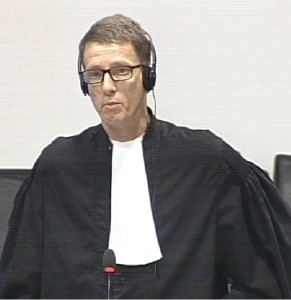
International Nuon Chea Defense Counsel Victor Koppe
When Mr. Lysak was about to ask about the meeting at Phnom Trael that took place “a couple of months” after the liberation day, Mr. Koppe interjected and said that the witness had testified it took place one month after the liberation day. Mr. Lysak said that he had also said it took place three months after the liberation day.
He then asked to explain who the chiefs of the 50-member and 100-member units were. The witness did not give a clear answer. Mr. Lysak asked whether the people whether this term was not used to describe leaders of the prior regime. He said that these people were “called by Angkar” for re-education. There were instructions not to take revenge against Lon Nol soldiers, since some of them were related to the local villagers.
Mr. Lysak then inquired whether it was a meeting that included only Sector 13 cadres or also other sectors. Mr. Van replied that Sector 13 was part of the Southwest Zone. The meeting was only for Sector 13 and there were no participants from Sector 25 or 33.
In his first interview, he had said that the meeting took place at Phnom Trael and that Ta Mok instructed not to kill colonels or people who held higher ranks.[12] In his next interview, he had said that Ta Saom announced that second lieutenant to colonel were not to be harmed.[13] Lastly, when he testified in front of the Supreme Court Chamber, he had said that Ta Mok was not present at the meeting and that former soldiers up to the rank of colonel should not be harmed.[14] Mr. Lysak wanted to know why his account of the details of the meetings had changed. He said that “it was not my intention” to make differing statements and that he was standing by his previous statements. Furthermore, he said that he was “getting old” and could not recall everything. He wanted to tell the truth “in order to maintain peace in Cambodia.”
Mr. Lysak pressed on and inquired how well he understood the ranks that were used under Lon Nol regime. He replied that he was not familiar with the structure. “However, I heard about the second lieutenant and the colonel or whether that person was a captain.”
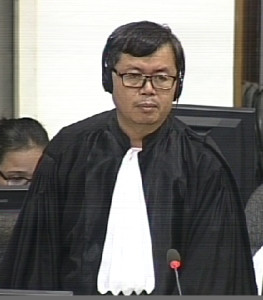
National Khieu Samphan Defense counsel Kong Sam Onn
This prompted Mr. Lysak to refer to his testimony in July in which he had acknowledged that his knowledge of military ranks was limited.[15] He asked whether his knowledge about who was not to be harmed was not accurate. Mr. Koppe interjected and said that the question was repetitive and that he had already said that everyone from the rank of the colonel down were not to be harmed. Khieu Samphan Defense Counsel Kong Sam Onn also interjected and said that it was wrong on the side of the Prosecution that the witness was not familiar with the ranks. Mr. Lysak replied that the witness had said himself that his familiarity with the ranks was limited. The objections were overruled. Mr. Lysak repeated his question. He said that no one in his village held the rank from the second lieutenant to the colonel. He was not really familiar with the names of the specific ranks.
Lon Nol soldiers
After the last break, Mr. Lysak referred back his interview, in which he had said that Ta Sokhon was taken away by Ta Mok’s cadres.[16] He wanted to know when this took place and who these cadres were. He answered that he did not know that he was arrested by Ta Mok. What was different from what Ta Mok said, Ta Mok had said that commune chiefs and provincial chiefs had “no right to kill people.” The witness saw a document in 1975, in which people were categorized into groups of children, old people, New People and Old People. The commune where the person was arrested was called Bang Srang Ey Commune. The commune chief was Sok Sary. Mr. Lysak wanted to know why he had said that Ta Mok’s cadre took this person away – whether he was called Sok Sary or Sok Sohon. He replied that Ta Mok was responsible for the zone, so the cadres were under his responsibility.
Mr. Lysak wanted to know what happened to the residents when Ang Ta Saom Village was captured. He replied that the office of Tram Kok was in Ang Ta Saom area. The area was liberated before 1973. Some soldiers had been transferred to that place later on. He did not see any soldiers at the time.
Mr. Lysak read out an excerpt of another witness’s testimony.[17] He then wanted to know whether the re-education camp 204 was the same education center that his brother was sent to. He answered that he only learned about this re-education office when his brother was sent there. The person who was responsible for re-education center, Chheng, was also responsible for “finding food” for people. The witness did not know whether this person was from Kus or not.
Mr. Lysak then moved on to 17 April 1975. He had said that Lon Nol soldiers were gathered at Champha Pagoa. Mr. Lysak wanted to know what happened there the following months. The witness replied that he was assigned to “solve the food supply” within Cheang Tong commune. “We had package rice for people.” Mr. Lysak asked how the Lon Nol soldiers were gathered at Wat Champha and what happened to them. He answered that he did not know where those soldiers were sent to. However, they were gathered close to the mountain in Sector 105.
Mr. Lysak said that Um Saroeun had testified that former officials were taken away and disappeared since.[18] Um Hoeun, who had worked at the security center, had said that all former soldiers with ranks were taken away.[19] Mr. Lysak wanted to know whether this refreshed the witness’s memory as to what happened. Mr. Van answered that Yeay Khom had assigned him to be responsible for the food supply. A person called Phy was responsible for people. He did not know whether there were killings or executions at other places. He denied that Ta Mok was present at Wat Champhar Leu. “I rarely saw him. Most of the time, I saw him at the yearly conference.”
Mr. Lysak then wanted to know how former Lon Nol officials were identified as such. He answered that it was identified “through the family origin”. Some soldiers went to their respective birth village.
Mr. Lysak referred to another witness’s statement and asked whether Mr. Van helped Yeay Boeun to prepare biographies.[20] He answered that he had already left to Kieng Svay. It was not difficult to identify the people, because the people knew, for example, that his brother had been the commune chief. Mr. Lysak referred to Mr. Van’s testimony in front of the Supreme Court Chamber, during which he had said that his brother’s biography “was found out.”[21] He explained that the own biography could not be hidden, since people knew each other. He met Chim, who was in charge of the district military, when his brother was sent away. Chim met Yeay Khom, who said that she also did not know who sent his brother to the re-education center. It was said that the village chief did so on advice of Morn, who worked for the commune.
Mr. Lysak read out an excerpt of the witness’s DC-Cam statement, in which he had said that he had to intervene when his brother was sent to the re-education center.[22] He replied that he did intervene. “So [Chhim] told me to stay calm, but I could not stay calm, so I meet Yeay Khom. I asked Yeay Khom to forgive my brother”.
Back to the treatment of Lon Nol soldiers
Mr. Lysak turned to his last question and wanted to know whether the policy not to harm Lon Nol soldiers that he had heard of during the meeting was subsequently changed. Mr. Van replied that he did not know whether there were changes in policies. He never received information regarding changes in policy. Mr. Lysak said that there was “substantial evidence” on the case file about the killing of Lon Nol soldiers after the meeting that the witness had described. He gave the example of the killing of Lon Nol soldiers between 22 and 30 March 1976 that also included lower-ranking soldiers at S-21.[23] Mr. Lysak wanted to know whether the meeting that he attended in Takeo Provincial Town before or after March 1976. He answered that he did not recall it well. “I only knew what I was assigned to do.” He was assigned to manage the rice supply.
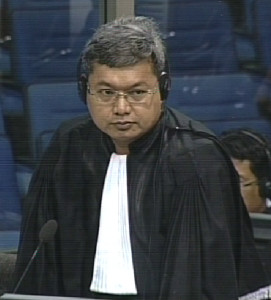
National Civil Party Lead Co-Lawyer Pich Ang
With this, Mr. Lysak finished his line of questioning and handed over to the Civil Party Lead Co-Lawyers. Pich Ang asked why Mr. Van sought help from Yeay Khom so that his older brother would not be killed. He answered that he went to see her to make a report that he had an elder brother who had been sent away. He had told her that he had not seen him yet, to which Yeay Khom replied that his brother had been sent away already. “She blamed me not to inform me prior to his transfer. She advised me to bring wife and children to live with me and my parents.” Office 204 was there for those who committed moral offences or those who committed wrongs. Before this, it was a warehouse to store weapons and arms. Chheng was one of the soldiers, who committed a moral offence and then sent to “the base area” by the regiment. He was sent there to produce weapons at the office. He did not know why his brother was sent to the re-education center.
At this point, the President adjourned the hearing. It will continue tomorrow, February 02 2016 at 9 am with the testimony of Sao Van. Witness 2-TCW-1008 will be on the reserve.
[1] E319/36.
[2] The President said this was the transcript of 02 February 2015. In fact, the appeal hearing took place on 02 July 2015. Page 18 in Khmer, page 20 in English and page 23 in French.
[3] E3/9647, at 00975721 (KH), 00992985 (EN), 00996561 (FR).
[4] E3/9118, at 00957793-94 (KH), 01098761 (EN) and 00957819 (KH), 01098778 (EN).
[5] E3/9455, at 00893277 (KH), answer 9.
[6] The French transcript indicates “20 grams”. The English transcript is not available, but there might have been a translation error here. The President later asked about “cans” and not “cams” (phonetic spelling).
[7] E3/232, at 00017122 (KH), 00182633 (EN), 00323935 (FR).
[8] E3/330, at 00000712 (KH), 00182547(EN), 00301331 (FR).
[9] E3/8, at 00075909 (KH), 00104053 (EN), 00301277 (FR).
[10] E3/9587, at answer 21 and 23.
[11] E3/9118, at 00957780-91 (KH), 01098752 (EN) .
[12] E3/9118, at 00957793-94 (KH), 01098761 (EN).
[13] E3/9455, at answer 9 .
[14] F1/1.1, at 10:21:51-10:24:07.
[15] Testimony of July 2 2015, at 15:13:36.
[16] E3/9118, at 00957819 (KH), 01098778 (EN).
[17] E3/3232, at 00217652 (KH), 00753656-57 (FR).
[18] E1/283.1, at 10:01:3210:06-27
[19] E3/9582, at answer 113.
[20] E3/9480, at answers 254-255.
[21] F1/1.1, at 14:44:06, Testimony of Sao Van, 02 July 2015.
[22] E3/9118, at 00957792 (KH), 01098760 (EN) and 00957808 (KH), 01098770-71 (EN).
[23] E3/1539.
